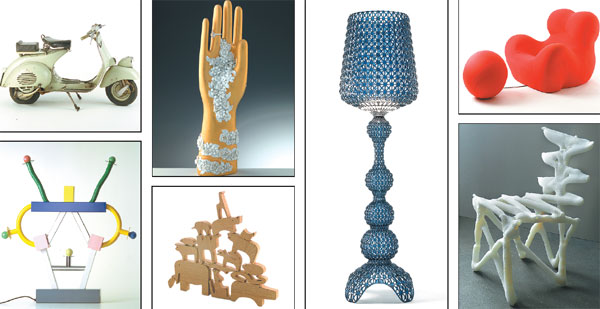When a scooter becomes art
A show at the National Museum of China highlights modern Italian design, including the iconic Vespa. Lin Qi reports.
The 1953 romantic comedy Roman Holiday elevated Audrey Hepburn to international fame. It also brought worldwide attention to Vespa, a scooter designed in the late 1940s by Corradino D'Ascanio.
In the film, Hepburn and Gregory Peck rode a Vespa around the streets of Rome. Its appearance in movie posters gave a great boost to its sales.
The Vespa in the film, the oldest known model, fetched 191,000 euros ($208,000) in an online auction in March.
Italian manufacturer Piaggio sold about one million Vespa scooters in the 1950s, and one is now on show at the National Museum of China as part of Series Off Series, an exhibition on modern Italian design running through July 25.
The scooter design shows how Italian designers managed to make a product that became an icon of modern life despite a shortage of raw materials after World War II.
Vespa means "wasp" in Italian, and was named for the similar shape and sound it made. While cars remained a luxury, it fulfilled most people's need of an affordable vehicle for daily use.
Vespa is among some 200 Italian designs that are shown at Series Off Series. Other eye-catching objects include a Borsalino hat that was worn by Humphrey Bogart in the classic 1943 movie Casablanca and French creator Philippe Starck's unconventional citrus squeezers which resemble a squid.
"The exhibition navigates Italian creativity by displaying designs that are put into big and small-scale production for daily use and also items that were produced as limited editions," says Andrea Cancellato, director general of Triennale di Milano, which co-organized the exhibition.
A bulk of the works on show are from the collection of Triennale di Milano's design museum.
Ettore Francesco Sequi, the Italian ambassador to China, says the word "Italy" means design and to know "what is Italian design", one needs to understand how the creative industry works in the country.
He says the objects at the exhibition show not only a combination of beauty and function but also a pursuit of high quality and energy saving; and they demonstrate that Italy's design industry holds dear to high standards through an emphasis on innovation and low cost.
A fine example: a Solar Bottle invented based on the solar water-disinfection system, an inexpensive method developed in the 1980s to purify water by using solar energy.
The container has a flat shape so that it is easy to transport. It can absorb ultraviolet and infrared rays from the sun, which destroy bacteria, viruses and worms in water. It provides a low-cost solution for people who only have biologically contaminated water to drink.
Italian designer Alberto Meda, 72, says he was motivated to create the bottle in 2000 during a business trip to Ethiopia. There, he saw an emergency situation in which some 1.2 million people had no potable drinking water.
It took Meda six years to find a purification method. He worked with Argentine industrial designer Francisco Gomez Paz to choose the ideal materials for the bottle.
Meda says it is the duty of a designer to impart to industry a consciousness of environmental repercussions, and the designer should also be involved in a company's strategy planning so that he can indicate a direction for sustainable growth.
Some other objects on show celebrate the core value of Italy's high artisanship, which Sequi says "shares similarities with China's cultural lineage and therefore will have resonance among Chinese audiences".
The old Silk Road traders took delicate silk clothes woven by Chinese artisans to the Roman Empire and brought Roman-style glassware to China.
Italian architect and designer Andrea Branzi, whose vase design Iceberg is part of the current exhibition, says that unlike conventional manual work, contemporary artisanship is centered around "a strong interaction" between artisan-operators and advanced technologies.
He says an artisan today manages his work with sophisticated machines.
Italian art is familiar to visitors to the National Museum of China: The institution has held three exhibitions over the past five years introducing classic Italian art.
The current exhibition on modern Italian design meets China's ambition to boost its own creative industry and to nurture more designers.
Cancellato says both China and Italy boast a long-standing history of artisanship and establishing colleges to cultivate designers, and she hopes to strengthen exchanges in the field.
She says Triennale di Milano's organizing committee toured Beijing, Chongqing, Chengdu and Guangzhou in January 2016 to promote the 21st edition of its international exhibition in March.
Cancellato says there are plans to exhibit more Chinese designs at the triennale's design museum in Milan. Right now, she adds, talks are in progress for touring the triennale to Shenzhen.
Contact the writer at linqi@chinadaily.com.cn
|
Series Off Series is an ongoing exhibition on modern Italian design at the National Museum of China. A Vespa scooter (top left) is one of the star exhibits. Photos Provided To China Daily |
(China Daily 05/15/2017 page20)















